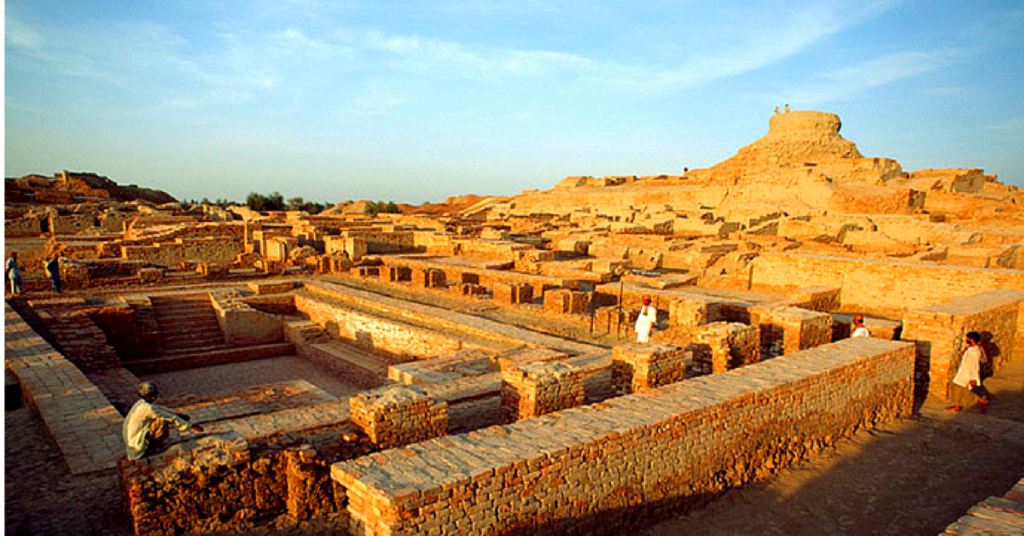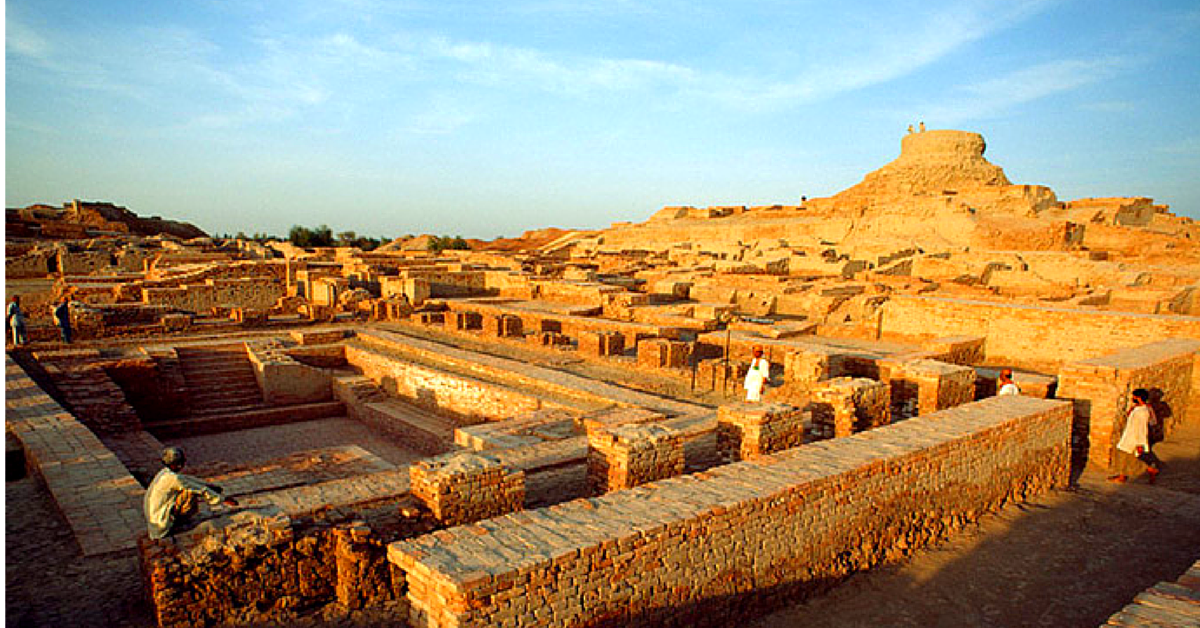Table of Contents
ToggleTop 17 Interesting Facts about Mohenjo-daro: The Ancient Indus Valley
Mohenjo-daro, one of the most significant urban centers of the ancient Indus Valley Civilization, dates back to around 2500 BCE. It thrived as a sophisticated, well-planned city with cutting-edge infrastructure, and it was situated in modern-day Pakistan. The name, which means “Mound of the Dead,” alludes to the magnificence of the ancient remnants of the city.
The city is well known for its precise grid-like design, which includes granaries, public baths, streets lined with baked-brick homes, and an extremely sophisticated drainage system that outperformed that of some contemporary cities. One of Mohenjo-daro’s most famous buildings, The Great Bath, emphasizes the significance of ceremonial bathing in the community.

The artisans of Mohenjo-daro were proficient in metalworking, ceramics, and beadwork. However, because their script has not yet been decoded, a great deal about their language, government, and way of life is still unknown.
Scholars continue to argue about several ideas on the decline of civilization around 1900 BCE, ranging from invasions to climate change. Mohenjo-daro is still a symbol of the architectural and urban triumphs of ancient South Asia, even in spite of its collapse.
Here are some of the top interesting facts about the Mohenjo-Daro Civilization, unraveling the greatness and mysteries surrounding this ancient city.
1. Mohenjo-Daro: The “Mound of the Dead”
The Sindhi language is where the word Mohenjo-Daro originates, and it means “Mound of the Dead.” This name implies that the location was a cemetery or that it was connected to a significant accident. It’s interesting to note that the current name of the city was chosen by the residents; the original name of the city is still unknown because the Indus Valley Civilization’s script cannot be deciphered.
2. Among the World’s Oldest Urban Settlements
During its peak about 2500 BCE, Mohenjo-Daro was one of the biggest towns of the Indus Valley Civilization. It is considered one among the first examples of advanced urban life, along with other ancient towns such as Ur in Mesopotamia and Thebes in Egypt. Its sophisticated drainage systems, well-designed streets, and striking architecture all serve to highlight the highly developed engineering and thought processes of its residents.
3. Advanced Urban Planning and Architecture
The painstaking planning that went into creating the city of Mohenjo-Daro shows an amazing level of expertise for its period regarding urban design. The Lower City, home to the vast majority of people, and the Citadel, home to significant buildings, comprised the two primary portions of the city. Similar to contemporary urban planning, the streets were arranged in a grid form, with the principal streets running perpendicular to one another.
At Mohenjo-Daro, baked bricks were used to build multi-roomed homes with courtyards. In other cases, houses had more than one story, indicating a social hierarchy. Large public structures such as granaries and warehouses are indicative of a highly developed administrative structure and concentrated authority.
4. The Great Bath: A Marvel of Ancient Engineering
A massive public water tank situated in the Citadel, the Great Bath is one of Mohenjo-Daro’s most amazing architectural features. The Great Bath, which is roughly 12 meters by 7 meters and has a depth of 2.4 meters, is regarded as one of the first public water tanks or pools. Watertight bricks, covered in a layer of bitumen, were used in the construction of the Bath.
According to scholars, the Great Bath may have served a ceremonial or religious function, maybe including ritual purification. This notion is supported by the fact that it was housed in the Citadel, the city’s administrative and religious hub.
5. Sophisticated Drainage and Water Management Systems
The extremely advanced drainage system of Mohenjo-Daro is among its most remarkable features. Wastewater was routed into covered sewers that ran along the streets, and almost every home in the city had access to a well or other water supply. The actual streets were surfaced, and inspection holes were used to clean the drains on a regular basis.
The Mohenjo-Daro people prioritized public health and hygiene to an extent that was unmatched in other ancient civilizations, as seen by their meticulous attention to cleanliness and sanitation.
6. A Flourishing Economy Based on Agriculture and Trade
The Indus Valley Civilization, of which Mohenjo-Daro was a part, was a flourishing society built on trade, agriculture, and handicrafts. Crops like wheat, barley, and cotton could be grown in the rich plains of the Indus River. The finding of seals, ceramics, and other items from both Mesopotamia and other nearby regions indicates that the city also participated in trade with that region.
Due to its location beside the Indus River, Mohenjo-Daro was a major hub for trade, with commodities traveling through the city that included lapis lazuli, silver, copper, gold, and other resources. The site’s standardized weights and measures add more evidence of a well-run, controlled trading system.
7. Indus Script: A Writing System Yet to Be Discovered
The indecipherable Indus writing is one of the long-standing mysteries of Mohenjo-Daro. Despite the discovery of thousands of writings on seals, ceramics, and other artifacts, researchers are still unable to decipher the language spoken by the Indus Valley Civilization’s inhabitants.
Because of our limited understanding of the writing, Mohenjo-Daro’s culture, religion, and system of government remain mysterious. There have been numerous attempts to decipher the script, but no agreement has been reached, leaving many facets of the culture unknown.

8. Lack of Monumental Temples or Palaces
There is little trace of elaborate temples or palaces in Mohenjo-Daro, in contrast to other ancient civilizations like Mesopotamia and Egypt. Because of its absence, academics think that the city’s religious and political structures were maybe more dispersed than those of other ancient societies.
The absence of colossal architectural designs might indicate a more egalitarian society or that their religious customs did not center around expansive temple complexes like to those in Sumer or Egypt. Alternatively, the hub of religious or ceremonial life may have been the Great Bath and other community buildings.
9. The Mohenjo-Daro Seals
At Mohenjo-Daro, more than 2,000 seals have been discovered. These seals frequently feature animals like tigers, bulls, elephants, and other mythological characters. These seals were probably used in trade to identify the owner or place of origin of goods and to label them. The seals are more mysterious and significant because of their elaborately carved motifs and Indus script inscriptions.
The “Pashupati Seal,” which features a seated man surrounded by animals, is the most well-known of these seals. According to some academics, the figure depicts a divinity, probably an ancestor of the Hindu deity Shiva. The precise meaning of the seal is still up for discussion, though.
10. Mysterious Decline and Abandonment
Historians and archaeologists continue to disagree over the fall of Mohenjo-Daro around 1900 BCE. A number of explanations have been put out, such as flooding or changes in the Indus River’s course, or even a fall in trade.
Additionally, there is evidence that suggests the city may have been abandoned gradually as opposed to suddenly, given that certain buildings exhibit signs of reconstruction and maintenance. According to a different argument, the city’s downfall may have been caused by changes in monsoon patterns brought about by climate change, which would have affected agricultural output.
11. No Clear Evidence of Warfare
Mohenjo-Daro appears to have had very little armed conflict or warfare, in contrast to many other ancient civilizations. There are no massive weaponry, fortifications, or battle-related artifacts that archaeologists have discovered. Some have conjectured that the city would have been relatively tranquil due to its absence, with a populace more preoccupied with trade, agriculture, and handicrafts than with military conquest.
Nonetheless, the absence of proof does not imply the nonexistence of conflict. Rather of an outside invasion, some academics believe that the city’s demise may have been caused by natural calamities or internal social and political instability.
12. Mining and Discovering
Early in the 1920s, archaeologist R. D. Banerji of the Archaeological Survey of India made the initial discovery of Mohenjo-Daro. Numerous excavations have been carried out since then, uncovering a wealth of relics, buildings, and information about the ancient city. But most of the city is still hidden beneath layers of soil, unexplored, and waiting to be discovered.
Environmental reasons, tourism-related degradation, and negligence have all contributed to the growing concerns in recent years regarding the preservation of Mohenjo-Daro. The site is being protected and conserved for future generations, but maintaining a balance between preservation and ongoing research is still a struggle.
13. Potential Deities and Religious Rituals
The finding of figures and seals offers some insight into Mohenjo-Daro’s religious rituals, even though much of it is still up for speculation. The well-known bronze statue of a young woman known as the “Dancing Girl” alludes to the potential for ritualistic or creative expression.
Furthermore, the previously mentioned Pashupati Seal might point to early manifestations of Hinduism or the worship of proto-Shiva deities. The Great Bath’s reliance on water may also allude to their religious practices’ sacrosanctity and ritual purification.
14. The Role and Position of Women in Mohenjo-Daro
Although the position of women in Mohenjo-Daro is still unknown, objects like jewelry, figurines, and domestic goods imply that women may have held important positions in society. Numerous female figurines have been found, some of which show ladies dressed elaborately. This suggests that women may have participated in religious or ceremonial duties.
It is challenging to pinpoint the precise status and duties of women in society because of the unintelligible writing, but archeological discoveries indicate that they were significant players in both the public and home domains.
15. Mohenjo-Daro in Popular Culture
Mohenjo-Daro has captivated the interest of academics, authors, and filmmakers in equal measure. Many books, documentaries, and even a Bollywood film called Mohenjo Daro (2016) have discussed the city’s mysterious past and advanced civilization. Despite being a work of fiction, the movie revived interest in the ancient city and its importance to world history.
Mohenjo-Daro still fascinates academics and visitors today, serving as a symbol of South Asia’s rich cultural legacy. Because of its international significance and the necessity of continuous conservation efforts, it has been inducted as a UNESCO World Heritage Site.
16. The Importance of Handicrafts and Pottery
Mohenjo-Daro pottery exhibits a great degree of artistic expression and craftsmanship. Typically, flower themes, animal motifs, and geometric designs were hand-painted on the ceramics. The everyday lives, commercial activities, and aesthetic sensibilities of the city’s residents are revealed by these objects.
Craftspeople at Mohenjo-Daro produced elaborate jewelry, tools, and decorative items in addition to pottery, using resources including gold, silver, and copper. Numerous craft workshops have been found, indicating that the city was a center of trade and production.
17. The Legacy of Mohenjo-Daro and the Indus Valley Civilization
The history of human civilization has been profoundly impacted by the legacy of Mohenjo-Daro and the larger Indus Valley Civilization. The city’s cutting-edge social structure, urban planning, and technical advancements shaped later cultures and established the foundation for contemporary cities.
Mohenjo-Daro is a monument to human creativity and the capacity to build vibrant urban environments, despite its mysteries. Mohenjo-Daro was an important aspect of the Indus Valley Civilization, which is still studied and respected for its contributions to the evolution of early cultures.
Conclusion: One of the world’s most fascinating and significant archaeological sites is still Mohenjo-Daro. It was distinct from other ancient civilizations by its excellent drainage systems, advanced urban design, enigmatic Indus writing, and lack of conflict. The discoveries unearthed at Mohenjo-Daro offer important insight into the life of its people and the larger Indus Valley Civilization, despite the mysteries that still encircle the city.
Mohenjo-Daro will surely continue to be a key location for learning about the emergence of urban civilizations and the evolution of prehistoric human societies as long as researchers are able to explore and maintain this historic site. Its legacy is genuinely ageless in terms of historical significance and cultural influence.


